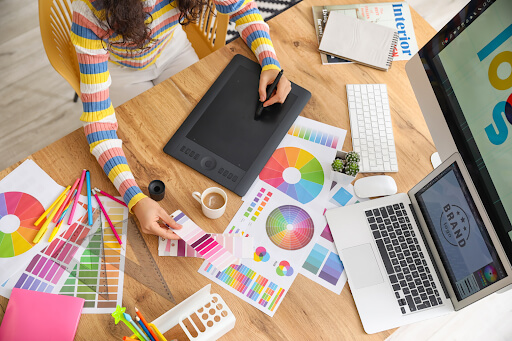 1-800-805-5783
1-800-805-5783 
In today’s rapidly evolving digital landscape, effective product design is crucial for businesses looking to stay competitive and meet the ever-changing needs of their customers. Whether it’s developing a mobile app, designing a website, or creating a user-friendly software interface, product design principles and approaches play a vital role in crafting successful digital products.
Product design goes beyond aesthetics and encompasses the entire user experience, from the initial idea to the final implementation. It involves understanding user needs, identifying market opportunities, and creating solutions that provide value and solve problems. Effective product design becomes even more critical in the digital realm, where technology and user expectations constantly evolve.
Design thinking, a human-centric approach to innovation, is the foundation for the product design process. It integrates people’s needs, technology’s possibilities, and business success requirements. Design thinking allows designers to better understand users, empathize with their needs, define the problem, generate creative solutions, prototype and test ideas, and iterate based on user feedback.

The design thinking process consists of several key phases:
By following the design thinking process, designers can approach product design with a user-centric mindset, resulting in products that are more intuitive, functional, and aligned with user expectations.
The product design and development process is a series of steps that product teams follow while developing a digital product. While the specific steps may vary depending on the project, the overall flow typically includes the following:
Collaboration and communication between designers, developers, and stakeholders are crucial throughout the product design process to ensure a cohesive and successful product.
As technology advances, the future of digital product design holds exciting possibilities. Emerging trends such as artificial intelligence, voice user interfaces, and virtual and augmented reality are reshaping how users interact with digital products.
Designers must stay abreast of these trends and incorporate them into their design processes. However, it’s important to remember that modern product design trends do not exist in isolation. Instead, they build upon the foundations of past innovations and technological developments.
1. Accessibility Takes Center Stage: Accessibility and inclusive design became a top priority, ensuring digital products cater to diverse user needs and abilities.
2. Minimalism Reimagined: Minimalism remained popular but evolved to focus on creating clear, usable interfaces while incorporating subtle details for user engagement.
3. Microinteractions Gain Attention: Small, purposeful interactions within interfaces gained focus, enhancing user experience and emotional connection.
4. Human-Centered Design Reigns Supreme: The emphasis on understanding user needs and emotions through research and iteration remained fundamental.
1. AI-powered Design Tools: AI tools gained traction, assisting with tasks like layout generation, user flow optimization, and personalization.
2. Conversational UI Boom: Chatbots and voice assistants continued to evolve, offering more natural and intuitive interactions with digital products.
3. 3D Design Integration: 3D design tools became more accessible, creating more prosperous and immersive user experiences.
4. Augmented Reality (AR) & Virtual Reality (VR) Experiences: Continued growth in AR/VR applications across various fields, like product visualization and training.
5. Data-driven Design Decisions: Leveraging data analytics to inform design choices and personalization has become increasingly important.
6. Focus on Ethical Design: Considerations for responsible data practices, user privacy, and unbiased algorithms gained prominence.
1. Dark Mode Preference: Users increasingly prefer dark mode options in digital interfaces for their aesthetic appeal and potential benefits like reduced eye strain, especially in low-light environments. Dark mode also caters to accessibility needs for users with sensitivity to bright light or vision impairments.
2. Sustainable Design Practices: There’s a growing emphasis on designing digital products with eco-friendly principles. This involves using sustainable materials, minimizing energy consumption, and optimizing resource efficiency throughout the product lifecycle.
3. Motion Design & Microanimations: Digital interfaces continue to incorporate subtle animations and micro-interactions to improve user engagement and enhance the overall experience. These animations serve functional purposes, such as providing feedback, guiding users through interactions, and adding visual interest and delight.
4. Personalization & Customization: Offering personalized experiences based on user preferences and behavior has become a key trend in digital design. By tailoring content, recommendations, and interactions to individual users, companies can enhance engagement, foster customer loyalty, and improve overall satisfaction.
Effective digital product design is a multifaceted discipline that requires a deep understanding of user needs, market opportunities, and the latest design trends. By following the principles of design thinking and adhering to a well-defined product design process, designers can create products that are not only visually appealing but also functional, intuitive, and aligned with user expectations.
As the digital landscape continues to evolve, businesses must prioritize effective product design to provide exceptional user experiences and maintain a competitive edge in the market. By embracing an innovative and customer-centric approach to digital product design, businesses can drive growth, enhance customer satisfaction, and achieve their strategic goals.